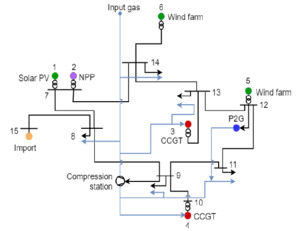Acronyms
CCGTs Combined Cycle Gas Turbines
FR Functional Requirement
IES Integrated Energy Sytstems
LOOP Loss of Offsite Power
NPP Nuclear Power Plants
cNNP conventional NPP
aNNP advanced NPP
PV Solar Photovoltaics
P2G Power-to-gas
SMR Small Modula Reactors
SoSs Systems-of-Systems
WF Wind Farms
1. Questions
Integrated Energy Systems (IESs) are systems-of-systems (SoSs) that include gas and electricity production, conversion, storage systems and infrastructures (Di Maio, Tonicello, and Zio 2022). In this work, we objectively consider the contribution of nuclear Small Modular Reactor (SMRs) to the resilience of IESs. We refer to the Functional Requirements (FRs) of Nuclear Power Plants (NPPs) listed in Table 1 and identify those useful for resilience (Chen et al. 2016; Greene 2018). FR 1 ensures that NPPs are capable of withstanding and absorbing credible external accidents by avoiding dependent failure mechanisms with the other systems of the IESs, thereby facilitating IESs recovery and restoration. FRs 2, 3 and 7 make NPPs independent from the offsite power supply, in normal operation as well as in shutdown conditions. FR 4 ensures that the NPPs are not made unavailable by events in which their power supply is necessary. FR 5 reduces the NPPs recovery time to support the IESs operation. FR 6 implies that the NPPs are to work in traditional baseload configuration as well as in load-follow configuration.
2. Methods
We consider an IES of literature (Di Maio, Tonicello, and Zio 2022) comprised of two Combined Cycle Gas Turbines (CCGTs) plants, a NPP, two Wind Farms (WFs), a Solar Photovoltaics (PV) field and a Power-to-gas (P2G) station. The IES considered is plotted in Fig. 1 (black line is the electrical grid and blue line is the gas grid). We analyze the contribution to resilience of two different types of NPP that can be integrated in the IES: a conventional NPP (cNPP) consisting of a single 360 MWe reactor unit, and an advanced NPP (aNPP) consisting of four identical SMR units amounting to the same total power of 360 Mwe, and whose design features (e.g., reactor vessel layout, aspect ratio, level of reactor building) meet the FRs (Table 3).
The cNPP could be damaged by the occurrence of an IES-wide natural event, given that it only partially meets the FR1. The aNPP, on the contrary, fully meets the FR 1 thanks to the integral reactor vessel layout and below-grade construction of the reactor building, and, therefore, it is not damaged by the occurrence of an IES-wide natural event. Yet, in case a direct damage to the cNPP were to occur, for example by a Loss of Offsite Power (LOOP) event, safe cooling can be ensured for a limited period only by safety systems whose power for functioning is provided by diesel generators or batteries; conversely, the aNPP can rely on passive shutdown cooling indefinitely, without the need of emergency power. Furthermore, in the event of damages to other production plants within the IES, the modular aNPP, thanks to its high operational flexibility (i.e., FR 4 and FR 6), can operate one or more SMR units to supply housekeeping and core self-cooling power (if needed), while the other reactor units provide power for the restoration of the damaged parts of the IES. Note that, if necessary, the aNNP can even switch to island mode operation (FR 5), isolating the NPP from the electrical grid and reducing its power level to satisfy its own housekeeping electrical loads. Finally, the aNPPs provide robust load-following capability (FR 6), thanks to its modularity, to meet varying and dynamic load demands by reducing the power level of one or more SMR units.
3. Findings
SMRs can play a role for the resilience of IESs. They have design features that meet the FRs of NPPs for providing safety and resilience. By a qualitative analysis of a typical IES, it has been shown that SMRs can guarantee prompt and effective recovery and restoration of damaged IES plants. In conclusion, SMRs should be considered as flexible power production plants to add resilience to IESs.


